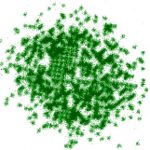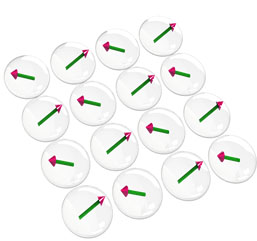In a paper published Sept. 29 in the journal of Science, experimentalists at Princeton, led by Prof. Waseem Bakr, and several theorists, including Ehsan Khatami, an assistant professor of physics and astronomy atSJSU, report their direct observation of an exotic magnetic phase of matter that could help explain how high-temperature superconductivity — the complete loss of resistance to electric flow— works.
In their experiment, Bakr and the group used lithium atoms cooled down to billionths of a degree above absolute zero (< -273 degrees Celsius), a temperature at which quantum mechanical effects dominate, and used lasers to trap atoms in a small region of space, only a few tens of micrometers across. They also used lasers to create a virtual 2D crystal, resembling an empty egg-tray, known as the optical lattice. An atomic microscope was then used to image atoms that were loaded on this lattice.
 Researchers found that applying a large magnetic field — the effect that causes bar magnets to attract or repel each other — to these atoms causes their intrinsic magnetic fields to alternate in alignment in a checkerboard pattern while slightly leaning away from each other, a state termed “canted antiferromagnetism”.
Researchers found that applying a large magnetic field — the effect that causes bar magnets to attract or repel each other — to these atoms causes their intrinsic magnetic fields to alternate in alignment in a checkerboard pattern while slightly leaning away from each other, a state termed “canted antiferromagnetism”.
The experiment is designed so that atoms can hop from one site to the neighboring sites of the “egg-tray”, while mostly avoiding each other on the same site. If we “look” at these particles at high temperatures, they have so much energy they will be moving around and bouncing off each other randomly. If the temperature is low, however, a completely different picture emerges. What we will see under the microscope would be exotic behaviors w e are not used to through our everyday experiences with classical particles. Atoms start to “collaborate” to try to optimize the use of the little energy they have left.
e are not used to through our everyday experiences with classical particles. Atoms start to “collaborate” to try to optimize the use of the little energy they have left.
The collaboration between atoms becomes a lot more fascinating when there are two types of them mixed in on the optical lattice, such as in the Princeton experiment. Each atom can be thought of as bar magnet that can point its north pole either up or down. With an equal population of “up” and “down” atoms, they settle into a situation where their alignment alternates from one site to the neighboring site at low temperatures. In the experiment carried out at Princeton, a magnetic field resulted in an imbalance in the population of atoms and caused them to settle instead into an unusual magnetic state in which the anti-alignment of ups and downs is pushed to the plane perpendicular to the magnetic field but canted slightly in the direction of the field.
This study is an important step towards better understanding electronic properties of solids. The system simulated in this study is a near perfect realization of a theoretical model known as the Fermi-Hubbard model, widely believed to have the ingredients for describing high-temperature superconductivity in copper-oxide materials known as cuprates. Understanding the underlying quantum mechanism driving exotic behaviors such as superconductivity or the magnetic state observed in this study can help us design better materials with specific properties we can harness in technology, energy and industry applications.
Khatami used a state-of-the-art numerical technique he had helped develop to obtain exact results for the Fermi-Hubbard model with parameters relevant to the experiment. Comparisons of numerical results with the experimental measurements was crucial in guiding the experiments and allowed the team to obtain an estimate for the system’s temperature, verify how the population imbalance changes the correlations in the system, and characterize the new phase of atoms using those correlations.
Similar experiments, albeit in the absence of a magnetic field, were performed last year at Harvard, the Massachusetts Institute of Technology, and Ludwig Maximilian University of Munich. Khatami was also a part of the MIT study, which was published in Science last year.